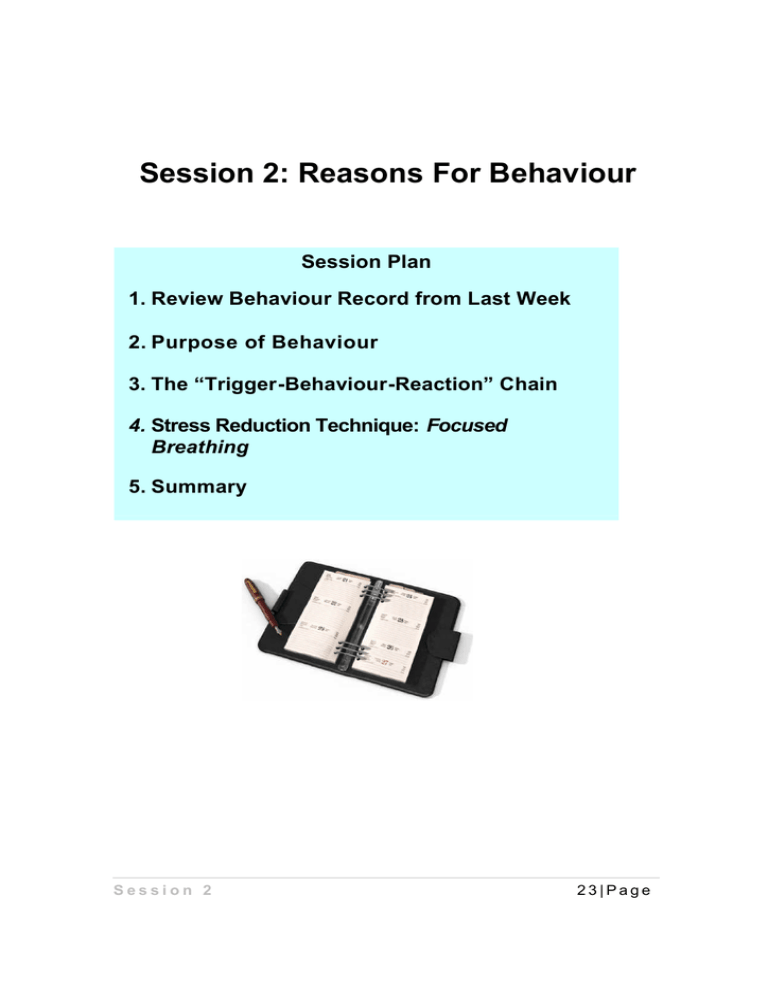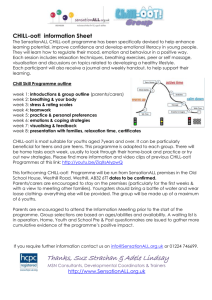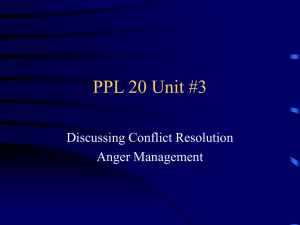Session 2: Reasons For Behaviour
advertisement

Session 2: Reasons For Behaviour Session Plan 1. Review Behaviour Record from Last Week 2. Purpose of Behaviour 3. The “Trigger-Behaviour-Reaction” Chain 4. Stress Reduction Technique: Focused Breathing 5. Summary Session 2 23|Page Review Behaviour Record Session 2 24|Page Session 2 25|Page Why Is The Behaviour Occurring? All behaviours have a purpose. For someone with memory problems, there may be several reasons why a difficult behaviour occurs. Example: Some people with memory problems have trouble understanding their feelings or expressing themselves . Your relative may not like being on their own or may phone you repeatedly to check when you are coming home. This may be because your relative is feeling lonely, bored or worried about something. If we want to stop these behaviours, first we have to understand why they are happening. All behaviours have a cause, it does not mean they are doing the behaviours on purpose. Behaviours can have many purposes, and these may change over time and from person to person. For people with memory problems there can be many causes for difficult behaviours, some common examples are: Forgetfulness No longer knowing what is socially acceptable Frustration No longer being able to entertain themselves Difficulty communicating distress Trying to make sense of why your relative does something can be hard. We will think first how their surroundings may affect them. Session 2 26|Page Understanding the Causes of Behaviour Now let’s look at the behaviour record again and try to answer these questions. Which behaviour would you like to focus on? Does the behaviour happen at the same time of the day? o If yes, what time is it? o What is usually happening at this time? Is your relative trying to communicate something (e.g. pain, thirst)? Is your relative frustrated, frightened or upset? (e.g. because they can’t do something anymore or they do not know who someone is) Is your relative restless and trying to find something to do? Is your relative trying to get away from something yo u are asking her/him to do? (e.g. bathing, toileting, taking medications) o If yes, what activity is your relative trying to get away from? Session 2 27|Page Ruling out Medical Problems Before trying to change your relative’s problem behaviours, it is important to make sure that his/her behaviour changes are not related to a medical problem. Some common medical problems that can affect behaviour include: 1. Medical conditions e.g. urinary tract infections (symptoms are burning pain on passing urine, urinating more frequently, cloudy or different smelling urine), constipation, pain or fever. 2. Medication side effects 3. Sensory impairments e.g. hearing loss or poor vision. It is important that these conditions, as well as others, be adequately diagnosed and treated by your doctor, as there may be underlying sources to your relative’s behaviour problems. Important Note: Always contact your relative’s doctor if there is any sudden change in their functioning. Session 2 28|Page The Trigger-Behaviour-Reaction Chain The first step in identifying the cause of someone’s behaviour is to pay attention to what happens before and after the behaviour. TRIGGERS occur before the behaviour and can be any of the following: An event or activity, such as noise or a demand that is being placed on the person (e.g. bathing). General things that affect a person for a long period of time (e.g. time of day, season, and/or physical illness). Cues in the environment, such as keys to the car may remind someone of driving or the presence of another person. BEHAVIOUR is what your relative does or what you do. REACTIONS occur immediately after the behaviour. They include what you do, how you feel, what the person you care for does. In other words, what happens after the behaviour. Reactions are very important to pay attention to, because they may cause, affect or change the problem behaviour. Session 2 29|Page It is helpful to think about the different phases of behaviour as a TriggerBehaviour-Reaction Chain: Trigger Behaviour Reaction A person with memory problems has a lot of difficulty learning new information or judging a situation. The only things you as a carer have control over are triggers and reactions. Occasionally, we can’t change the triggers. During these times, changing how you react to the behaviour may improve the situation. Example: When John goes to the shops with his brother Peter, it is often busy or loud. Peter finds this confusing, he becomes agitated and wants to go home. Although John may not be able to change the environment, he can reassure Peter and remain calm. As a result Peter is less distressed and able to continue shopping with John. Session 2 30|Page RECORDING the Trigger-Behaviour-Reaction Chain We are now going to take a few moments and to record a Trigger Behaviour - Reaction Chain. Example: Every morning at 8am, Jim gets the car keys from the key hook and tells his wife, Pat, “I am going out for a drive.” Pat reminds him that he no longer has a driving licence and is not allowed to drive. Jim responds by shouting “I don’t know what you are talking about” and walks towards the car. Pat says, “Alright, let’s go for a ride, but let me drive.” Jim lets Pat drive. Pat is upset with herself because she gave in to Jim’s behaviour. Date/ Time Day of week Every 8am morning Person Present Pat Jim Trigger Jim sees the car keys on the hook Pat reminds Jim that he no longer has a driving licence and is not allowed to drive Session 2 Behaviour Reaction Jim shouts and walks towards the car Pat feels upset and gives in to Jim’s behaviour Pat takes Jim for a drive 31|Page Exercise: Let’s complete this Behaviour Record now, using the behaviour you identified earlier (see page 27). See the next page for helpful questions to refer to as you do this exercise. Date/ Day of week Time Session 2 Person Present Trigger Behaviour 32|Page Reaction When completing the Behaviour Record, keep in mind the following questions: To work out the triggers: 1. What time of day was it? 2. Was the environment quiet or noisy? 3. Was the environment dark or bright? 4. Was your relative alone or was someone present? If so, who? 5. Was a particular event occurring, such as bathing, administering medications, or providing other direct care? 6. Did your relative want something such as food, a beverage, or keys? 7. How stressed did your relative feel? 8. Did your relative appear to be seeking attention? To work out the reaction: 9. Did you stop the event (e.g. bathing, administering medications, or providing other direct care)? 10. Did your relative gain access to an object s/he wanted (e.g. food, beverage, keys)? 11.Did your relative receive attention? 12.Did your level of stress increase or decrease? Session 2 33|Page We will now discuss the different ways we can change behaviours. These include the following: Changing the trigger Changing our reactions Changing the trigger and our reactions We will begin with an example: Example 1: Betty Problem behaviour: Wandering at night It is three o’clock in the morning and Betty wakes up and begins to walk around the house. Jane, her daughter, is sleeping. Betty paces throughout the house and wakes Jane up. Jane is upset, because she has a long day at work tomorrow. Jane says, “Mum, you need to go back to bed, it is 3 am.” Betty says, “I am not sleepy.” Jane shouts, “I can’t take this anymore.” Betty starts to cry. Trigger Betty wakes up at 3 am. Jane is sleeping. Betty does not want to go to bed; she is not sleepy. Behaviour Betty wanders at 3 am. Reaction Jane tells her Mum to go to sleep. Jane shouts. Betty cries. If Jane wants to keep her Mum from wandering at 3 am, what can she do? 1. Change the T (trigger) to prevent the wandering from occurring: * Make an appointment with Betty’s doctor to find out if there is a medical reason for her trouble sleeping (e.g. urinary tract infection, pain). If there is no medical problem, then. . . * Plan some activities to keep Betty awake during the day. Don’t let her nap! * Encourage Betty to exercise during the day (e.g., walking, stretching). * Develop a bedtime routine that takes place at the same time every night. * Do not allow Betty to have caffeine after lunch. * As a LAST RESORT, talk to Betty’s doctor, and ask her if there is anything Betty can take to improve her sleep. 2. Change the R (reaction) to prevent the behaviour from occurring again: * Gently remind Betty that it is dark outside and time to go to sleep; lead her back to bed; play soothing music or do something else that will help Betty to relax. * Jane could remind herself to approach the situation calmly and focus on the goal of the task (getting Betty back to sleep). This way, she will use her energy in a positive manner to problem -solve the situation, rather than reacting emotionally. Session 2 35 | P a g e Example 2: Joe Problem behaviour: Asking the same question repeatedly After breakfast, Joe asks his wife, Sandy, “What are you doing?” Sandy says, “I am cleaning up.” Five minutes later, Joe asks Sandy, “What are you doing?” Sandy says, “Washing the dishes.” Five minutes later, Joe asks, “What are you doing?” Sandy begins to get annoyed and says, “I just told you, I am doing the dishes. Stop asking me the same question.” Five minutes later Joe asks, “What are you doing?” Sandy is frustrated and feels helpless. Using Joe’s example, let’s complete the following log and questions together: First, identify the: Trigger Behaviour Reaction What could be the purpose of Joe’s behaviour? If Sandy wants to prevent the behaviour from occurring, what are some strategies she can use to prevent Joe’s behaviour from being triggered? How might Sandy react differently? Session 2 36 | P a g e Stress Reduction Technique: Focused Breathing Focused Breathing can be beneficial to carers for a number of reasons: It can be used to bring about a state of deep relaxation and ease the tension and stress that can be brought on by caring. It can help you learn to briefly focus your attention on something else, other than caring, allowing you time to focus on just you. Most importantly, through learning how to relax and take time for yourself, it will be easier to provide quality of care for the person you care for. Stress Rating Before Exercise First, please rate your level of stress or tension right now before we practice the Focused Breathing. On a scale of 1 to 5, how would you rate your tension? ______ . I am going to talk you through the Focused Breathing exercise now. Session 2 37 | P a g e Focused Breathing: Practice Session “You should begin this exercise by getting yourself into a comfortable position in your chair... Just settle back, and let the chair completely support your body... Feel yourself sinking into the chair, allowing all of your muscles to go loose and floppy... Now, take in a deep, signal breath, filling your lungs with air... holding it in until you notice a little tension building in your chest and then let the air out slowly, relaxing as you do... Close your eyes and take in another breath, holding the air in until you feel the tension, and then relax, let go completely... Now, let your breathing return to a normal and natural rhythm... Start to focus your mind on your breathing... Become very aware of your breathing. Pay close and careful attention to each and every breath... Just watch it... Observe it... Simply become aware of how easily and naturally your body breathes by itself, free and easy, in and out... At all times your body is breathing by itself, you don’t even have to think about it, your body breathes automatically, at all times, whether you are sound asleep or wide awake, aware or unaware... as long as you are alive, you are constantly breathing... And all you have to do right now is to simply become aware of this process, this process of your body breathing by itself... Notice the steady rhythm... the air coming in and going out again... [Pause] Allow your breathing to be natural and free... without trying to change and without trying to interfere... If your breathing is slow, let it be slow... If it is deep, let it be deep... If your breathing is shallow, let it be shallow... Just watch your body breathing by itself... Be aware of the cool air coming in through your nostrils... and then the warm air flowing out... Notice the slight pause between each inhalation and each exhalation... Session 2 38 | P a g e Notice your chest as it ever so slightly rises and falls with each automatic breath... as your lungs expand when the air flows in and then contracts when the air flows out... You may also notice your abdomen rising... and falling... each time you breathe in and breathe out... Experience the natural tides of your breath, the ebb... and the flow, as the air comes in... and flows out again... If your mind should wander or your attention is pulled somewhere else, simply catch yourself and refocus on your breathing... refocusing again and again if necessary... Do your best to keep your mind focused on your breathing... Just watching and observing... Nothing to change, nothing to hold onto, nothing to do... just awareness... watching... observing... and allowing your body to breathe free and easy... natural and automatic... [Longer pause] And now, as you continue to observe your body breathing by itself, you can begin to add a simple mental suggestion, a suggestion aimed at helping you experience even more relaxation and comfort... Right now, as you focus your mind on your breathing, you can begin to imagine that each time you breathe out, each time you exhale, you are letting go of unnecessary tension, letting go of negative thoughts or worries, letting go of more and more discomfort... Just let it all go... Allow yourself to breath in fresh, positive, and healthy thoughts and feelings... Breathe in the good... Breathe out the bad... And so with each complete breath cycle, you can allow and experience both your body and mind becoming more comfortable, more relaxed, and more at ease... Enjoy the natural mental and physical cleansing that your breathing can bring you, letting it carry you into a deeper and deeper state of relaxation and comfort... Enjoy the mental tranquility and the peacefulness that this breathing can bring to you... [Longer pause] In a moment, you are going to open your eyes and return to a more normal, alert, and wide-awake state... [Pause] Session 2 39 | P a g e Ok, I would like you to take in a nice, deep, refreshing, and energising breath, stretch comfortably and open your eyes, to end this relaxation...” Tension Rating After Exercise Now, please rate your tension or stress level from 1 to 5. How would you rate your tension level now after practicing the Focused Breathing exercise ________ ? 1. How are you feeling now? 2. Did your level of tension change? 3. What was this experience like for you? 4. Can you think of a specific event when you think this technique might have been helpful during a stressful caring situation? Session 2 40 | P a g e Summary Today we have talked about; The purpose of behaviour Ruling out medical problems Trigger-Behaviour-Reaction Chain Stress reduction technique: Focused Breathing FOR NEXT WEEK √ Focused Breathing: Before next week try and do this stress reduction exercise. √ Behaviour Record: Complete this record, on the next page, when your relative’s target behaviour occurs. We understand it may be difficult to complete the record each time the behaviour occurs, but please complete it as frequently as possible. Session 2 41 | P a g e Behaviour Record Please use this log to write down the things your relative does (or that you do) that upset you. Date/ Time Person Trigger Behaviour Reaction Day of Present week Session 2 42|Page



